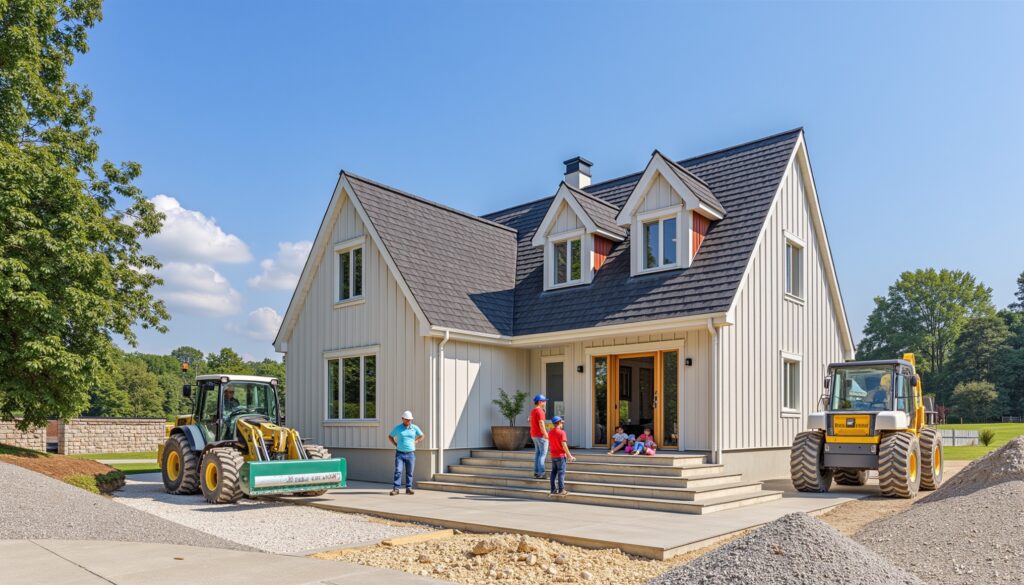When embarking on a construction or renovation project, one of the most critical steps to consider is site preparation.
Understanding site preparation costs is essential for both homeowners and builders as it sets the foundation for a successful project.
This guide will provide clarity on what site preparation entails, how to anticipate expenses, and strategies to manage your budget effectively.
Whether you’re planning to build your dream home or undertake a significant renovation, having a comprehensive understanding of site preparation costs will ensure you’re well-informed and financially prepared.

Key Takeaways
- Site preparation costs encompass various expenses necessary to ready a site for construction.
- Understanding the breakdown of site preparation expenses helps homeowners budget more effectively.
- Factors such as terrain, permits, and local regulation significantly influence site preparation costs.
- Implementing cost-saving tips can help minimize expenses without compromising quality during site preparation.
- Avoiding common mistakes in site preparation is crucial for efficient project execution and budget adherence.
1. What are Site Preparation Costs?
Site preparation costs refer to the expenses incurred in preparing a plot of land for construction or development.
This crucial phase involves various activities, including clearing debris, leveling the land, grading, and installing necessary utilities such as water and electricity.
Understanding site preparation costs is essential for anyone interested in real estate, as these expenses can significantly impact overall project budgets.
Factors affecting these costs include the size of the land, the type of soil, existing structures that may require demolition, and local regulations that may dictate certain procedures.
By accurately estimating site preparation costs, investors and developers can ensure that they allocate their budgets appropriately and avoid unexpected financial burdens during the construction phase.
2. Breakdown of Site Preparation Expenses
When considering a construction project, understanding site preparation costs is crucial for accurate budgeting and planning.
These expenses can vary significantly depending on the scope and specifics of your project.
Generally, site preparation costs encompass several essential activities, including land clearing, grading, excavation, and landscaping.
For instance, land clearing involves removing trees, shrubs, and debris, which can vary in cost based on the density and type of vegetation present.
Grading, which ensures the land is level for building, is another vital component, and its expenses can escalate if extensive grading is needed.
Additionally, if the site requires excavation for drainage or foundation work, those costs must also be factored into the overall budget.
Understanding these facets of site preparation costs not only helps in financial planning but also ensures that the groundwork for your construction is solid and compliant with local regulations.
‘The key to budgeting is not just knowing what your costs are but understanding how to manage them effectively.’ – Unknown

3. Factors Influencing Site Preparation Costs
When it comes to site preparation costs, several critical factors play a pivotal role in determining the overall expenses incurred before any construction begins.
First and foremost, the geographical location can significantly affect costs; urban areas with high demand for land may require more extensive preparation due to existing infrastructure.
Additionally, the type of soil present on the site directly influences site preparation costs—dense clay or rocky terrain may necessitate specialized machinery and more labor hours compared to sandy or loamy soils.
Environmental regulations are another vital consideration; sites that require environmental assessments or mitigation efforts can drive up preparation costs substantially.
Lastly, the intended use of the property impacts preparation needs—commercial developments often require more robust and extensive site work compared to residential projects.
By understanding these factors, investors and developers can better anticipate and budget for site preparation costs, ensuring a smoother project execution.
4. Cost-Saving Tips for Site Preparation
Site preparation costs can significantly impact your overall project budget, so implementing cost-saving strategies is essential for property developers and homeowners alike.
First, conduct thorough research to ensure you’re hiring reliable contractors with a good reputation, as their expertise can prevent costly mistakes and rework later on.
Second, consider performing some of the preliminary site preparation tasks yourself, such as clearing debris or landscaping, which can save on labor costs.
Third, avoid common pitfalls by understanding local zoning regulations and environmental assessments upfront; this way, you can avoid expensive delays or fines during the preparation phase.
Finally, always seek multiple bids from contractors to compare pricing and services offered, ensuring that you get the best value for your budget.
By utilizing these cost-saving tips, you can effectively reduce site preparation costs without compromising the quality of your project.

5. Common Mistakes to Avoid in Site Preparation
When embarking on a construction project, understanding site preparation costs is essential to prevent budget overruns and delays.
One common mistake is underestimating the complexity of the site.
Factors such as soil condition, vegetation, and existing structures can greatly impact preparation costs.
Additionally, failing to obtain the necessary permits can lead to costly fines and delays.
It’s also crucial to involve professionals early, as DIY approaches may save money upfront but can result in expensive repairs if not executed correctly.
Lastly, overlooking environmental assessments can lead to unforeseen expenses related to environmental compliance and remediation.
By avoiding these pitfalls, you can better manage site preparation costs and ensure a smoother construction process.
6. Conclusion: Budgeting for Site Preparation
In conclusion, understanding site preparation costs is essential for anyone considering a construction project in Costa Rica.
These costs can vary based on several factors, including the size and location of the property, the complexity of the terrain, and local regulations.
Proper budgeting for site preparation not only ensures that you have allotted enough funds for clearing, grading, and utility installation but also helps mitigate unexpected expenses that may arise during the construction process.
By factoring in these costs at the beginning of your project, you can create a more accurate financial plan, making your journey toward building your dream property in Costa Rica smoother and more successful.
Frequently Asked Questions
What are site preparation costs?
Site preparation costs refer to the expenses associated with preparing a construction site for building.
This includes clearing the land, grading, excavation, and any necessary fill work to ensure the site is ready for construction.
What factors influence site preparation costs?
Factors influencing site preparation costs can include the size and topography of the land, soil condition, location, and the complexity of the required preparation work.
Additionally, local labor costs and regulations can also impact the overall expenses.
What are some common expenses included in site preparation?
Common expenses in site preparation may include land clearing, demolition of existing structures, grading and leveling, excavation for foundation, installation of drainage systems, and landscaping for erosion control.
Are there cost-saving tips for site preparation?
Yes, to save on site preparation costs, homeowners and builders can consider obtaining multiple quotes from contractors, scheduling work during off-peak seasons, using local resources, and carefully planning the layout to minimize disruption.
What are some mistakes to avoid during site preparation?
Common mistakes to avoid include underestimating the costs, neglecting proper site analysis, failing to account for drainage and erosion control, and not obtaining necessary permits or compliance with local regulations.





